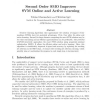2723 search results - page 25 / 545 » Learning lexicographic orders |
NECO
2008
13 years 7 months ago
2008
Iterative learning algorithms that approximate the solution of support vector machines (SVMs) have two potential advantages. First, they allow for online and active learning. Seco...
SLP
1989
13 years 8 months ago
1989
This paper describes a learning system, LASSY1, which explores domains represented by Prolog databases, and use its acquired knowledge to increase the efficiency of a Prolog inter...
MLDM
2009
Springer
13 years 12 months ago
2009
Springer
The new approach of relevant feature selection in machine learning is proposed for the case of ordered features. Feature selection and regularization of decision rule are combined ...
JMLR
2010
13 years 2 months ago
2010
Simple features constructed from order book data for the EURUSD currency pair were used to construct a set of kernels. These kernels were used both individually and simultaneously...
FLAIRS
2011
2011
Impact of Word Sense Disambiguation on Ordering Dictionary Definitions in Vocabulary Learning Tutors
12 years 11 months ago
Past research has shown that dictionaries and glosses can be beneficial in computer assisted language learning, particularly in vocabulary learning. We propose that L2 vocabulary ...


